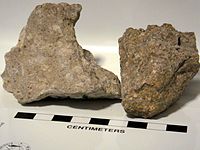Tephra

Volcanic tephra at Brown Bluff, Antarctica (2016)
Tephra is fragmental material produced by a volcanic eruption regardless of composition, fragment size, or emplacement mechanism.[1]

Tephra horizons in south-central Iceland: The thick and light-coloured layer at the centre of the photo is rhyolitic tephra from Hekla.
Volcanologists also refer to airborne fragments as pyroclasts. Once clasts have fallen to the ground, they remain as tephra unless hot enough to fuse together into pyroclastic rock or tuff.

A 2007 eruptive plume at Mount Etna produced volcanic ash, pumice, and lava bombs.
Contents
1 Overview
2 Classification
3 Etymology
4 References
5 External links
Overview

Rocks from the Bishop tuff, uncompressed with pumice on left; compressed with fiamme on right
The distribution of tephra following an eruption usually involves the largest boulders falling to the ground quickest, therefore closest to the vent, while smaller fragments travel further – ash can often travel for thousands of miles, even circumglobal, as it can stay in the stratosphere for days to weeks following an eruption.
When large amounts of tephra accumulate in the atmosphere from massive volcanic eruptions (or from a multitude of smaller eruptions occurring simultaneously), they can reflect light and heat from the sun back through the atmosphere, in some cases causing the temperature to drop, resulting in a temporary "volcanic winter". Tephra mixed in with precipitation can also be acidic and cause acid rain and snowfall.[citation needed]
Classification
Tephra fragments are classified by size:

Volcanic breccia in Jackson Hole.
Ash – particles smaller than 2 mm (0.08 inches) in diameter
Lapilli or volcanic cinders – between 2 and 64 mm (0.08 and 2.5 inches) in diameter
Volcanic bombs or volcanic blocks – larger than 64 mm (2.5 inches) in diameter
The use of tephra layers, which bear their own unique chemistry and character, as temporal marker horizons in archaeological and geological sites, is known as tephrochronology.
Etymology
The word "tephra" and "pyroclast" both derive from Greek: τέφρα tephra means "ash", while the word pyroclast is derived from the Greek πῦρ (pyr), meaning "fire", and κλαστός (klastos), meaning "broken in pieces".
References
^ This is the broad definition of tephra (Greek tephra, "ash") proposed by the Icelandic volcanologist Sigurður Þórarinsson (Sigurdur Thorarinsson) in 1954, in connection with the eruption of Hekla (Thorarinsson, "The eruption of Hekla, 1947-48II, 3, The tephra-fall from Hekla, March 29th, 1947", Visindafélag Íslendinga (1954:1-3).
External links
 Media related to Tephra at Wikimedia Commons
Media related to Tephra at Wikimedia Commons- How Volcanoes Work
- Volcanic Materials Identification
